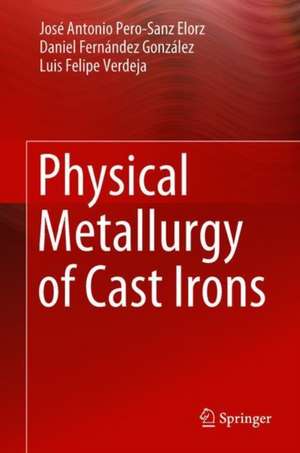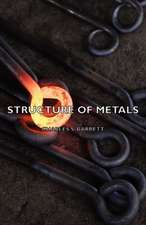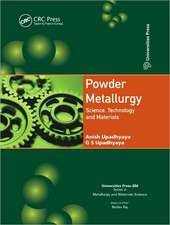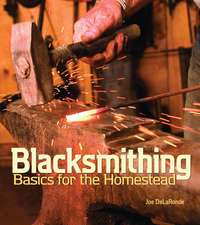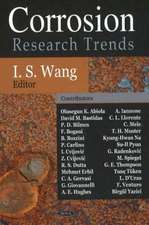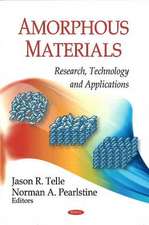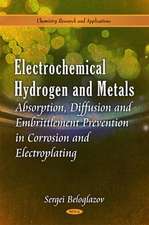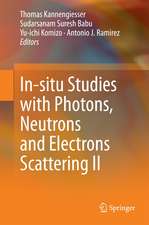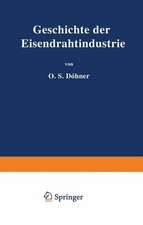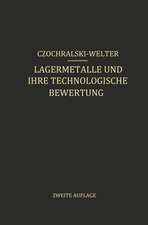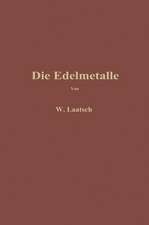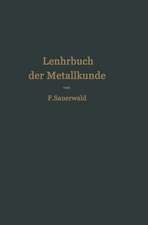Physical Metallurgy of Cast Irons
Autor José Antonio Pero-Sanz Elorz, Daniel Fernández González, Luis Felipe Verdejaen Limba Engleză Hardback – 3 sep 2018
| Toate formatele și edițiile | Preț | Express |
|---|---|---|
| Paperback (1) | 505.68 lei 38-44 zile | |
| Springer International Publishing – 14 dec 2018 | 505.68 lei 38-44 zile | |
| Hardback (1) | 651.51 lei 3-5 săpt. | |
| Springer International Publishing – 3 sep 2018 | 651.51 lei 3-5 săpt. |
Preț: 651.51 lei
Preț vechi: 766.49 lei
-15% Nou
Puncte Express: 977
Preț estimativ în valută:
124.68€ • 135.39$ • 104.73£
124.68€ • 135.39$ • 104.73£
Carte disponibilă
Livrare economică 01-15 aprilie
Preluare comenzi: 021 569.72.76
Specificații
ISBN-13: 9783319973128
ISBN-10: 3319973126
Pagini: 325
Ilustrații: XV, 343 p. 205 illus., 32 illus. in color.
Dimensiuni: 155 x 235 mm
Greutate: 0.73 kg
Ediția:1st ed. 2018
Editura: Springer International Publishing
Colecția Springer
Locul publicării:Cham, Switzerland
ISBN-10: 3319973126
Pagini: 325
Ilustrații: XV, 343 p. 205 illus., 32 illus. in color.
Dimensiuni: 155 x 235 mm
Greutate: 0.73 kg
Ediția:1st ed. 2018
Editura: Springer International Publishing
Colecția Springer
Locul publicării:Cham, Switzerland
Cuprins
Fe-C system. Stable and metastable equilibrium diagrams.- Stable eutectic. Graphite morphologies.- Compromise between stable and metastable solidifications.- Stable and metastable cooling compromise in solid state.- General properties of non-alloyed gray cast irons (or low alloy) and flake graphite.- Malleable irons.- Spheroidal graphite cast irons (or ductile cast iron).- Fe-C-Cr system.- Composition, structure, and properties of high alloy cast irons.- Exercises, problems, and case studies.- Fundamentals of the cupola furnace. Applications. Mass and energy balances.
Notă biografică
José Antonio Pero-Sanz Elorz (1934-2012) had a Doctorate in Engineering from the University of Barcelona (Spain) and was a founder member of the International Metallographic Society (USA). He was adviser on Physical Metallurgy matters for the United Nations Industrial Development Organization (UNIDO) as well as for Arcelor Mittal-Europe and was member of the Conseil Scientifique des Usines Renault. He was responsible for the Research and Development Group of Materials in the Oviedo and Madrid School of Mines and professor in both schools for more than 30 years. He published several books: Materiales Metálicos. Solidificación, Diagramas, Transformaciones (Dossat, Madrid, 1988); Materiales para Ingeniería. Fundiciones Férreas (Dossat, Madrid, 1994); Ciencia e Ingeniería de Materiales. Estructura, Transformaciones, Propiedades y Selección (5 editions, Dossat 2000, Madrid, 2000); Aceros. Metalurgia Física, Selección y Diseño (Dossat 2000, Madrid, 2004); Solidification and Solid-state Transformations of Metals and Alloys (Elsevier, Amsterdam, 2017); Materiales para Ingeniería. Fundiciones Férreas (Pedeca Press Publicaciones S. L. U., Madrid, 2018).
Daniel Fernández González has a Master in Mining Engineering and Materials Science and Technology from the University of Oviedo and curently persuades his PhD studies. He has published the book Materiales para Ingeniería. Fundiciones Férreas.
Luis Felipe Verdeja González has a PhD in Chemical Sciences from the University of Oviedo, where he is a professor of Materials Science and head of the Siderurgy, Metals and Materials Group (Sid-Met-Mat). His research focuses in the application, maintenance, and wear of refractory linings in blast furnaces and other metal and steels production processes. He has published 8 books: Ciencia de Materiales (Eléctricos) (Servicio de Publicaciones de la Universidad de Oviedo, Oviedo,1994); Metalurgia Extractiva. Volumen I. Fundamentos (Síntesis, Madrid, 2000); Metalurgia Extractiva. Volumen II. Procesos de Obtención (Síntesis, Madrid, 2000); Prácticas y Problemas de Siderurgia (Fundación Luis Fernández Velasco, Oviedo, 2000); Materiales Refractarios y Cerámicos (Síntesis, Madrid, 2008); Refractory and Ceramic Materials (Síntesis, Madrid, 2014); Solidification and Solid-state Transformations of Metals and Alloys (Elsevier, Amsterdam, 2017); Materiales para Ingeniería. Fundiciones Férreas (Pedeca Press Publicaciones S. L. U., Madrid, 2018).
Daniel Fernández González has a Master in Mining Engineering and Materials Science and Technology from the University of Oviedo and curently persuades his PhD studies. He has published the book Materiales para Ingeniería. Fundiciones Férreas.
Luis Felipe Verdeja González has a PhD in Chemical Sciences from the University of Oviedo, where he is a professor of Materials Science and head of the Siderurgy, Metals and Materials Group (Sid-Met-Mat). His research focuses in the application, maintenance, and wear of refractory linings in blast furnaces and other metal and steels production processes. He has published 8 books: Ciencia de Materiales (Eléctricos) (Servicio de Publicaciones de la Universidad de Oviedo, Oviedo,1994); Metalurgia Extractiva. Volumen I. Fundamentos (Síntesis, Madrid, 2000); Metalurgia Extractiva. Volumen II. Procesos de Obtención (Síntesis, Madrid, 2000); Prácticas y Problemas de Siderurgia (Fundación Luis Fernández Velasco, Oviedo, 2000); Materiales Refractarios y Cerámicos (Síntesis, Madrid, 2008); Refractory and Ceramic Materials (Síntesis, Madrid, 2014); Solidification and Solid-state Transformations of Metals and Alloys (Elsevier, Amsterdam, 2017); Materiales para Ingeniería. Fundiciones Férreas (Pedeca Press Publicaciones S. L. U., Madrid, 2018).
Textul de pe ultima copertă
This textbook focuses on cast irons, the second material in production and consumption after steel. The authors describe the Fe-C stable and metastable diagrams from the physical-chemical metallurgy point of view. The main properties of cast irons are presented and justified for all kinds of cast irons: low cost, excellent castability, mechanical properties depending on the graphite morphology (gray irons) and high wear resistance (white irons). The physical metallurgy of highly alloyed cast irons is also described, particularly that one of those used as a consequence of their abrasion, corrosion and heat resistance. The book presents exercises, problems and cases studies, with different sections dedicated to the molding practice. The book finishes with the production cast irons in the cupola furnace. This concise textbook is particularly of interest for students and engineers that work in industries related to cast irons.
Caracteristici
Presents 100 solved exercises, problems and case studies Specially conceived for graduate and undergraduate courses and technicians working in foundries Includes the molding practices as well as the production of cast irons in the cupola furnace
